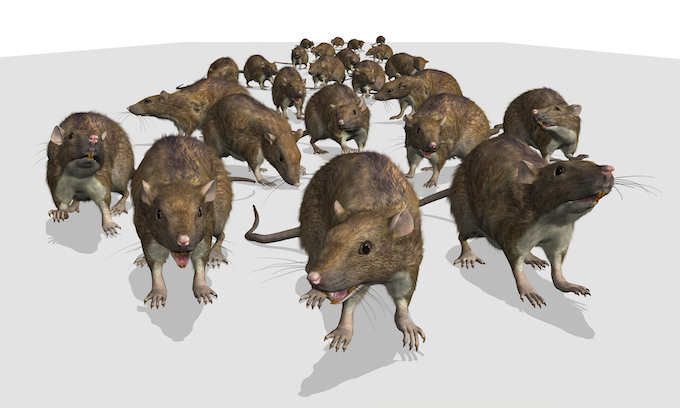The COVID-19 pandemic has commanded a new way of life, and not just for people — even Chicago’s rat population has been affected.
Restaurants can remain open for delivery and takeout under Gov. J.B. Pritzker’s stay-at-home order, but plenty have reduced hours or have closed temporarily or permanently, casualties of the coronavirus outbreak.
That means some formerly reliable food sources for rats, such as dumpsters behind restaurants or overflowing outdoor garbage cans stuffed to the brim daily with Chicagoans’ food scraps, now sit empty. But rats are resilient and they’ll move into residential homes, eat dog feces, or even cannibalize dead or young rats before they’ll starve.
Now, hundreds of thousands of Norway rats, the kind that live in Chicago and don’t usually travel more than 150 feet from burrow to food source, suddenly are changing up their routines, boldly searching farther for food, including during the day — a shift for the normally nocturnal animals, said Robert Villamil, owner of Chicago-based Crow Pest Control Inc. Despite the explosion in rat boldness, the business has seen its commercial work slow with bars and restaurants closed or limited to takeout orders, as it’s been getting more business from residential customers.
“Rats have a hierarchy and they’re very territorial,” said Villamil, whose overall business is down 5 to 10 percent because of less commercial work. “As they look for food, people are noticing them more. Rats carry disease and they’re very unsightly, so it’s a big thing. People are wanting to take steps to keep rats away from their homes.”
Rats have a “complex social hierarchy within their colonies,” said Jim Fredericks, of the National Pest Management Association. There are “alpha males,” which get to eat first and have first mating opportunities, then there are “beta males” and rats of lesser importance, which may be forced to sleep outside the safety of a nest or burrow.
“As resources become scarce, whether that be food, or harborage, nesting places, that imposes stress upon that rat community, so to speak, and when there’s stress you do see increased aggressive behavior within that rat social system,” he said.
Fredericks said in many large cities — including, he suspects, Chicago — videos have surfaced, showing rats acting boldly on largely abandoned streets, much more visible now as they seek out new food sources.
Experts think the city could be capitalizing on the fact that rats are food stressed. Despite repeated requests for comment, Cristina Villarreal, spokeswoman for Chicago’s Department of Streets and Sanitation would not answer questions about whether the changes affect the city’s rat response.
Intead, Villarreal provided a two-sentence statement saying, in part, the department’s “aggressive rodent baiting continues every day with 16-18 crews out across the City.”
Fredericks said he doesn’t expect the rodent population is going to be permanently or even noticeably dented by the new normal, but said it “does create a pest management opportunity.” Curtis Rand, the vice president of operations for Rose Pest Control, which operates throughout northern Illinois and northwest Indiana, also said the environment creates “a huge opportunity,” for cities with rat abatement programs to be aggressive in their use of baiting because the rats are hungrier than usual.
“Obviously, the less food source the more attractive the bait,” Rand said.
“When you put a hamburger in front of someone’s face every day, the chances of them walking over and going to get a hot dog are few and far between because they’ve got a hamburger there,” Rand said.
Municipalities he’s aware of that have rodent programs are seeing an increase in interest in the bait being laid out, he said.
“What we’re starting to see is the rodent devices are getting a lot more activity, which is a good sign. That means we’re starting to get bait into the population. And so you’re gonna see some benefits from that,” he said.
Rand also recommended any city that has areas notoriously popular with rats should place bait near those sites. “Hopefully we’ll come out of this with lower populations,” he said.
Rats are known to resort to cannibalism in times of food stress, such as the conditions the stay-at-home order is creating. Villamil, from Crow Pest Control, said crews have reported rats stuck in traps that have been all or partially eaten by other rats, leaving just a head behind. Cannibalism is further evidence that rodents are going hungry, Villamil said.
“Because the restaurants are closed, food is scarce,” he said.
Villamil also said there’s been an uptick in calls from homeowners noticing burrows in their yards. At homes, Villamil said he typically catches one or two rats in exterior areas or garages. On one recent call, he captured seven.
“That tells me they’re moving from busier streets to quieter streets closer to people’s homes,” Villamil said.
Fredericks said homeowners should use some of their extra time at home to look for any potential entry points into their home and shove a steel wool pad in any holes larger than a quarter: a quarter-sized hole is all a rat needs to squeeze inside, while mice only need a dime-sized hole. Rats are known to chew through plastic trash bins and they’ll make a meal of dog waste because dog food is densely packed with protein and nutrients that are not all absorbed by the dog.
“Believe me, they have a wide and varied and sometimes utterly disgusting diet,” Fredericks said. “It’s one of the reasons why rats are considered pests and are associated with disease and illness — and have been for centuries — because they tend to live in and feed in places that are not hospitable to what you and I might think of.”
___
(c)2020 the Chicago Tribune
Visit the Chicago Tribune at www.chicagotribune.com
Distributed by Tribune Content Agency, LLC.
—-
This content is published through a licensing agreement with Acquire Media using its NewsEdge technology.


















Recent Comments